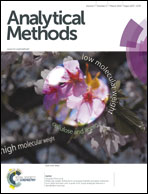Tungsten oxide nanowires for chemical detection
Abstract
Tungsten oxide nanowires have been synthesized on alumina substrates in order to fabricate sensing devices. Metallic tungsten films have been deposited by RF magnetron sputtering and then oxidized in a controlled atmosphere, in order to obtain a dense mat of nanowires. Two batches of samples have been prepared, starting from 18 nm and 180 nm tungsten films, and the influence of the sputtering temperature on the morphology has been investigated. Raman and XRD spectroscopies were used to confirm the crystalline structure of the material. The chemical sensing performance of n-type tungsten oxide nanowires has been evaluated towards some oxidizing and reducing species, together with the influence of relative humidity. Fabricated WO3 nanowires exhibit a very good sensitivity, especially for the detection of NH3, NO2 and CO.


 Please wait while we load your content...
Please wait while we load your content...